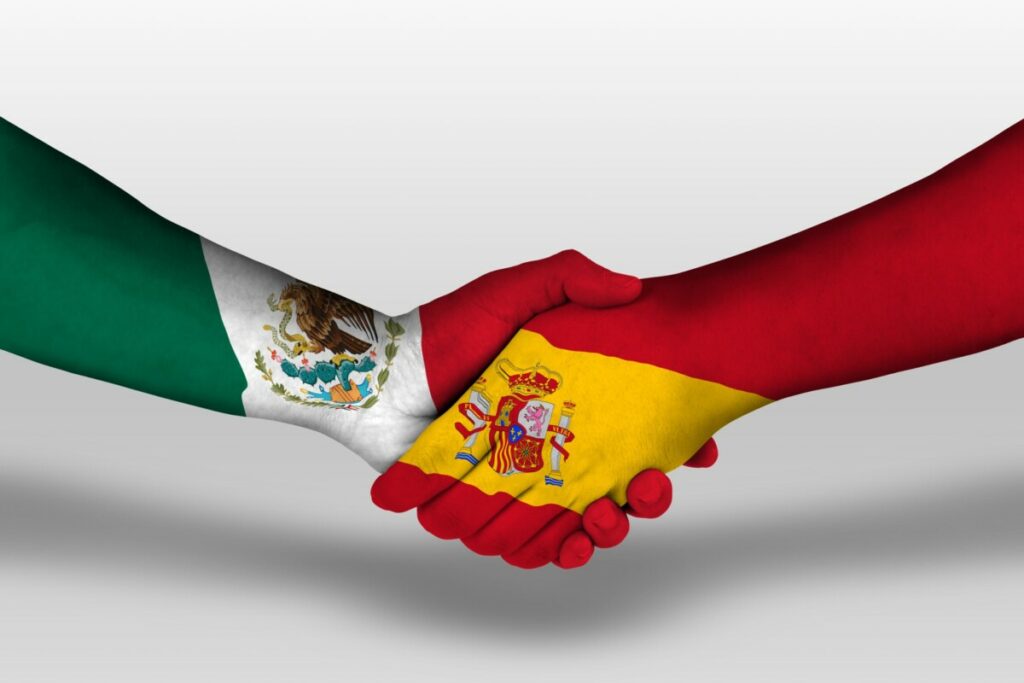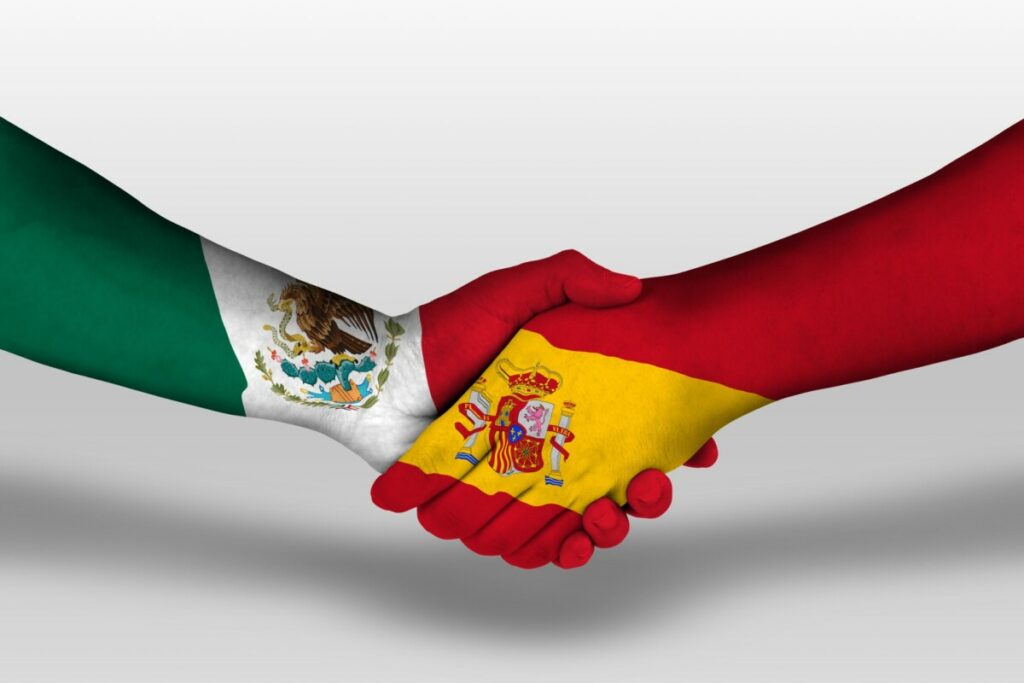
Spanish is a language spoken by over 559 million people around the world. Even though both countries speak the same language, there are concrete differences between the grammar, vocabulary, and pronunciation of Spanish in different countries.
Mexico and Spain commonly use the language of Spanish in their way of speaking. However, there are similarities and differences in the way each country communicates through vocabulary, pronunciation, tense, grammar, and culture.
Check out the differences between Spanish in Mexico vs. Spain below.
Do People in Mexico and Spain Speak the Same Language?
In general, both countries speak Spanish. If you have ever learned and spoken Spanish, you will be able to speak Spanish in both of the countries, except for the fact that their styles are both different in nature.
Spanish from both countries is different in style and way of speaking. When paying attention to both types of Spanish, notice the many differences between the two.
There are different types of accents in Spain and Mexico, just like how other countries have different accents from each other. In Mexico, the letters S, Z, and C are pronounced as an E, whereas the letter S in Spain sounds like S and Z, and C sounds like Th.
Mexico is closer to the United States border than Spain, therefore, its language is similar to the English language in style. Spain sounds different than the English language because it is quite far away from the United Kingdom and the United States, so the language hasn’t been heavily influenced by English in the same way that Mexican Spanish has been.
All of these differences make it hard to know the differences between the Spanish language and the way it is used in both countries. But there is hope knowing that there are a few differences in the context, and you can learn to decipher the Spanish language in both scenarios.
What is the Difference Between Spain and Mexico Spanish?
Spanish spoken in Spain and Mexican Spanish are different in mannerisms used, style, and more, but luckily, the two languages are similar enough that if you know Mexican Spanish, you will be able to communicate with someone who knows Spain Spanish, and vice versa. They just might think that you have bad grammar and may ask for clarification on a few words.
Vocabulary
The difference between Spain Spanish and Mexican Spanish involves a few important words and phrases to remember. Different words are used and refer to the same actions for both countries.
For example, in Spain, one may say, “conducir a coche”, and in Mexico, one will say, “manejar a carro”, which both mean the phrase, “to drive a car”.
- The word “glasses” in Mexico is “lentes”, whereas in Spain it is “gafas”.
- Car in Spain is referred to as, “coche”, and in Mexico, the word is referred to as “coche”, “carro”, or even “auto”.
- The word “computer” in Spanish is “computadora” in Spanish. In Spain, “computadora” is referred to as “ordenador”.
- The word “blanket” in Mexico is “Sabana”, whereas in Spain it’s “manta”.
- The word “potato” in Spain is “patata”, and in Mexico, it’s “papa”.
Even the same words can be pronounced differently in Mexico and Spain, so if you learn one instead of the other and then visit or move to a country that speaks Spanish differently than how you were taught, that doesn’t mean that they are wrong. It just means that they were taught different things than you.
Accents and Pronunciation
Pronunciations in Spain and Mexico will not always be the same. For this reason, it can be difficult to hear the same word being pronounced by a native of each country.
Castilian Spanish, the type of Spanish often spoken in Spain, has a distinct way of pronouncing syllables.
- ‘Ce’, ‘Ci’
- ‘Za’, ‘Ze’, ‘Zo’, and ‘Zu’
In Spain, the syllables sound closer to the way the English pronunciations are, except, in Mexico, they use the word “seseo”, which means they pronounce the syllabus by using an S sound instead.
The English accent is different wherever you go, therefore, it would make sense that Spain and Mexico would have different ways of pronouncing their syllables and words.
Vosotros and Ustedes
When learning the Spanish language, learning the word “vosotros” meaning “you” is best if planning on going to Spain. In Mexico, the word is “ustedes”. Making sure you conjugate the words correctly will help you to know how to best pronounce words depending on each country. Here are some examples of common phrases translates into both Mexican and Castilian Spanish.
Mexican Spanish: ¿Ustedes hablan español?
English Translation: Do you guys speak Spanish?
Spain Spanish: ¿Vosotros habláis español?
English Translation: Do you guys speak Spanish?
Past Tenses
The use of past tenses is another difference between Mexican and Spain Spanish. In Mexico, they use past tenses as much as in English, but in Spanish, they tend to favor the present perfect tense.
Spain Spanish uses past tense more frequently when it comes to saying a phrase when something has already been finished.
In Mexico, the Spanish language will use the preterite tense, which is used to describe actions from the past, with a clear beginning and an end.
Here are some examples of past tense sentences in both countries.
Mexico
Preterite Examples
Yo caminé al parque. (I walked to the park)
Yo corrí dos veces. (I ran two times)
Past Tense Examples
Ellos jugaron fútbol ayer. (They played soccer yesterday)
¿Cuántas galletas comiste? (How many cookies did you eat?)
Spain
He visto a Diego en la tienda. (I saw Diego at the store)
Te he llamado esta mañana, ¿por qué no me has atendido? (I called you this morning, why didn’t you pick up?)
Even though both countries use past tense in the Spanish language, they are used in a different contexts, depending on the country, time and place, and much more.
Direct Object Pronouns
Direct object pronouns are a word or a phrase that will receive the action of the verb. Direct object pronouns in Spanish are referred to as la, lo, los, and las. This determines what thing will be replaced, and who or what will be able to receive the action.
In Mexico, they will use direct object pronouns in their form of speech, whereas in Spain, they will use indirect object pronouns. Instead of using indirect pronouns when having to use direct pronouns is a popular practice Spain uses in their language.
Mexican Spanish Examples
Maria habló con Juan. (Maria talked to Juan)
No la podemos ayudar. (We can’t help you)
Spain Spanish Examples
Mara habló con Juan. (Mara talked to Juan)
No le podemos ayudar. (We can’t help you)
Grammar
Grammar is used the same way in most languages, however, sometimes the way it is used is different depending on which country the language is from.
The main difference between Spain and Mexican Spanish is the usage of the word, “Vosotros”, which means “for you all” is both considered the informal plural in Spain. In Mexico, “Ustedes” (for you all), is used both informally and in plural.
In this case, the conjugations in both countries will also be different for this reason.
In grammar, the words “Leísmo” and “Laísmo” are different. “Leísmo” is the incorrect usage of the indirect pronoun “le”. “Laísmo” is the incorrect usage of the direct object pronoun, “la”.
In Spain, many people will use the words, “le”, or “les”, instead of the “lo” or “los” that Mexico commonly uses.
Examples:
Leísmo in Spain: “Le vi ayer.”
Mexico: “Lo vi ayer.”
That’s just one of the grammatical differences between the Spanish used in both countries. Most people from Spain will use present perfect tense for any action that was finished and is related to the present.
Believe it or not, the English language doesn’t use this. Because of how different from English Castilian Spanish is, it is typically harder for English-speakers to learn Castilian Spanish than it is for them to learn Mexican Spanish.
Examples:
United States: I ate an apple this morning.
Spain: He comido una manzana esta mañana.
Mexico: Comí una manzana esta mañana.
United States: I went to Japan this summer.
Spain: He ido a Japon este verano.
Mexico: Fui a Japon este verano.
Communication Styles in Mexico and Spain

The communication styles in Mexico and Spain are surprisingly different. People from Mexico tend to be very friendly when they speak indirectly, in more of a nice manner.
Spain doesn’t follow those characteristics because their style is just different. They tend to speak more directly and often talk a lot. It may even feel as if they are disruptive when they speak to let all of their reasons and emotions out. This isn’t necessarily a bad thing. Each country has its own way of expressing its opinions and emotions in the Spanish language.
Both countries are similar in the way they communicate in a formal manner. Instead of being informal, both countries refer to people that they come in contact with by saying, Mr., Mrs., and so on.
If you know people from Spain and Mexico, compare how they speak Spanish, and you will likely notice stark differences. You may even notice that they speak English in different ways.
Cultural Differences
In Mexico and Spain, there are many cultural differences. For example, in Mexico, driving through the city will often take a long time. Many people will stop to talk to you along the way, and there is a ton of music, entertainment, and more on the side of the road that you can listen to and enjoy while going to your destination.
In Spain, the streets are oftentimes calm, especially when you get outside of large, bustling cities.
The difference in cultures can influence the way people speak Spanish, as the way that people speak Spanish is determined by the environment they live in, as is the case with any language. Depending on the country, one may be more respectful than the other.
Cultural differences have influenced the differences between Castilian and Mexican Spanish. Each country has a different lifestyle and way of speaking, and it is evident in the language differences listed above.
Which Spanish Should I Learn?
After all of this, which form of Spanish is better to speak? Well, it all depends on your preference. If English is your first language, it will be easier to learn Mexican Spanish. If you are looking for a challenge, then Castilian Spanish will be a good language to learn.
Either way, each language can be learned by anyone as long as they put in the effort. Spanish is one of the easier languages to learn, therefore, each version of Spanish shouldn’t be too difficult to learn and understand. When learning the Spanish language from one country, it will be easier to learn the differences in the next.
Knowing both versions of Spanish can broaden your understanding of each country in the way they speak. Also, you never know who you will talk to and what form of Spanish they speak, so it won’t hurt to learn both types of Spanish.
Conclusion
What we can gather from this information is that the culture and language in Mexico and Spain are different and similar in many ways. Both countries speak the same language but use different styles.
Despite these differences, both countries can come together in unity because they technically speak the same language and can easily understand each other. Different people from different backgrounds can learn the differences between both countries if they are fluent in Spanish.
From this point, learning the differences in conjugations and communication styles will come more naturally to the Spanish speaker. If you need extra resources in learning the differences between both languages, use Duolingo, use other Spanish-teaching websites or tools, or, if possible, visit Spain or Mexico for a long period of time and immerse yourself in the culture and language.
Overall, Castilian Spanish and Mexican Spanish are quite similar and different in various ways, but if you learn one type of Spanish, you will most likely be able to understand the other type of Spanish well enough to communicate with others.
